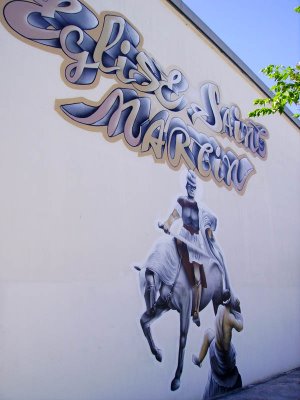 What would you get if the Catholic Church were as important a patron of contemporary art as it was in the Renaissance? An article by Xavier Ternisien (A Tarbes, les fresques d'un graffeur revivifient l'église Saint-Martin, February 16) yesterday in Le Monde has one possible answer (my translation and links added):
What would you get if the Catholic Church were as important a patron of contemporary art as it was in the Renaissance? An article by Xavier Ternisien (A Tarbes, les fresques d'un graffeur revivifient l'église Saint-Martin, February 16) yesterday in Le Monde has one possible answer (my translation and links added):The church of Saint-Martin, in Tarbes, is a soulless building. It looks like a gymnasium. Only a frayed tower, that residents compare to a minaret, indicates its religious function. The Sunday Mass brings together only about 70 people, mostly senior citizens. In this neighborhood of middle-class villas, some grumble against La Gespe, the "contemporary music hall" situated across from the church and that hosts hard rock concerts. It draws a noisy clientele that leaves beer cans behind.It may not be on the same level as the St. Martin of El Greco or the storiated capital in the Moissac cloister, but if someone learns something about the saint's life, so much the better.
The parish priest, Fr. André Pastor, had the idea to raise his church's profile. He imagined graffiti depicting the legend of St. Martin. "My first plan was to create a catechesis in images. A little bit like the sculptures found in cathedrals. The stones speak..." The director of La Gespe gave him the number of a graffiti artist -- or tagger -- from Toulouse, answering to the name of Snake. The priest consulted his parish council, made up of lay people. They were not enthusiastic. "You're going to dirty the wall!" exclaimed one pious layman. But Fr. Pastor made a strong argument for three frescos created by Snake in downtown Tarbes. The members of the parish council were convinced.
A dialogue then began between the 68-year-old priest, rather progressive, and the 31-year-old graffiti artist, who describes himself as "a believer" without practicing any religion. "The first time, I came to see the priest with my mother..." Snake began painting, around the age of 16, on public buildings and trains. In 1996, he was sentenced to three months in prison for having painted on a train station wall. "It's funny," he says. "Before, they made me pay when I tagged. Now, they pay me for it..."The artist was not familiar with the story of St. Martin, a soldier converted to Christianity who used his glaive to divide his coat in order to give half of it to a poor man freezing in the cold. Fr. Pastor gave him some books [like the Golden Legend] and engravings, from which Snake drew a plan. "He had drawn some angels," recalls Fr. Pastor. "I find it a bit much. He was leaning toward the religious side. And really, what does that mean, to depict angels these days?" The priest had another suggestion: the glaive should not be too prominent so as to avoid giving the fresco a warlike dimension. Snake chose a graffiti lettering instead of gothic letters (too religious), to tell the story of St. Martin. In December 2005, he brought out his spray paint cans and began to paint, favoring pastel colors. He did not add his own sign (a logo in the form of a dragon) at the bottom of the fresco, contenting himself with a discrete signature on a gray rock nearby. "That would have been too commercial."
Snake also decorated the façade of La Gespe, across from the church, with a fresco of Elvis Presley in his stage costume on a blue background. Elvis holds his microphone, and St. Martin holds his glaive, echoing each other. Snake has gone on to another church commission, arranged by Fr. Pastor, for the Chapelle Saint-Michel. This summer, on the morning of July 13, the Tour de France will begin its first stage from Tarbes. I'll be looking for an image of the church and La Gespe on the television coverage of the race.

Go Lance! oops. Or if the mega-churches sprouting around the country had an art budget, I wonder.
ReplyDelete